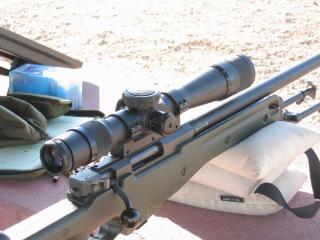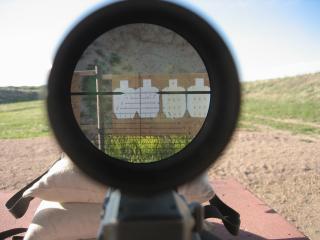Tube Diameter and Mechanical Limit of Elevation Travel

 US Optics 3.2-17x44mm SN-3 with 35mm tube has approx 18 mils total elevation in two turns,
ninety 0.1-mil clicks per revolution. Rifle is an AI-AWP.
When the elevation knob is adjusted, it physically moves an assembly -- some lenses and the
reticle -- inside the main tube body of the scope, just "under" the elevation knobs. This
assembly is called the "erector" assembly because it inverts ("erects") the image coming from the
objective lens. The erector assembly travels up and down as the elevation knob is turned, and
left to right as the windage knob is turned. The movement of the erector assembly moves the
"zero" of the reticle.
The erector's movement within the scope body is limited by the side of the main tube diameter of
the scope. Thus the larger the scope tube diameter, the more elevation travel will be
mechanically possible. (It is also possible that the elevation knob mechanism itself limits
travel before the mechanical limit of the erector. This is most common in "one turn" scopes like
the Leupold M3.)
Scope tube diameters include: 1" (25.4mm), 30mm, 34mm (Schmidt & Bender), 35mm (US Optics), and
40mm. The advantages of the larger tube diameters are more elevation travel available and a
stronger scope. The disadvantage of larger tube diameters is that the selection of scope rings
is few, however, there are several high-quality ring sets available for 34 and 35mm tubes.
Reticle Features

 View through Horus H25 reticle at approx 12x magnification, targets at 100 yards)
The second method for elevation specification is to use reticle features. Many reticle designs
have hash marks or dots down from the main cross hair which can be used for hold-over. In a FFP
scope, the angles demarcated will be the same at any scope magnification. In a SFP scope, the
angles demarcated will change as the scope magnification is changed. Thus, without overly
complex calculations, reticle-based holdover is most useful in a FFP scope.
Just like the "click" sizes, the spacing of the hash marks for reticle holdover in part determine
the smallest engage-able target size. For example, if a reticle has 1 MIL demarcations (ie, in a
mildot reticle) and you need to shoot a 10" square target at 600 yards, you need to hold
approximately 3.4 mils high, so you'd put the target approx 40% of the way from the 3rd to the
4th mark. If the target is small, there is no precise sight picture-- you're holding "in space"
again.
A more sophisticated reticle designed specifically for reticle-based holdover (and windage) is
the Horus. The Horus H25 reticle is mil-based, with small tick marks every 0.2mil. A 308 shooter with the
H25 reticle can shoot to 1000 yards using the reticle only.
For example, at the TACPRO 2005 sniper match, there was a stage in which 5 targets had to be
ranged and engaged with one shot each under a strict time limit. I ranged the targets with my
laser and wrote their distances on my note-pad. As I moved from target to target, I only needed
to look up the drop for that distance and use hold-over in the Horus H25 reticle. I didn't have
to fiddle with any knobs. This demonstrates the speed advantage of reticle-based holdover. A
shooter should try to memorize his drop values, and it also helps if he can remember the current target
distances or have a spotter to communicate them.

Engaging multiple targets with the Horus reticle at TACPRO 2005. Photo by Frankie Icenogle used with permission.
Hybrid Knob & Reticle
The last method for elevation specification is a hybrid, where the shooter might dial to an
intermediate zero like 500 yards from his primary 100 yard zero, and then use reticle-based
hold-under and hold-over for targets closer and further than the intermediate zero distance.
Reticle and hybrid holdover has the advantage of being much faster than dialing elevation changes
between shots at targets of different range. The downside is that sight picture precision is
reduced because of the larger granularity of reticle features vs. typical knob click values.
Again at the 2005 TACPRO sniper match, on a stage where I knew the distances beforehand (325,
375, 500), I dialed to 375, and noted the hold-under for 325 (0.4mil), and the holdover
(1.1mil). While shooting the stage, I merely used the appropriate hold-under/over points in the
reticle.
First Focal Plane vs Second Focal Plane
In variable power scopes, a first-focal plane (FFP) reticle configuration means that the angular
measure of the reticle features stays constant. No matter what magnification it is set at, 1 MOA
will be 1 MOA and 1 MIL will demarcate 1 MIL.
The FFP comes into play because with a wide range variable scope (my SN3 is 3.2-17x), dialing
down the power will widen the field of view. Target to target transition times are drastically
improved by widening the field of view. The ability to locate targets is enhanced by a wider
field of view. To use reticle based holdover without the need to adjust to a specific
magnification setting, the scope must have a FFP reticle.

 This IPSC silhouette target at 1520 yards is almost totally obscured by this FFP reticle.
Another advantage of the FFP is that ranging and miss-spotting can be done at any power and yield
direct accurate results.
Exit pupil size numbers increase as the scope magnification is dialed down. That's the math
behind the observation that a scope at a lower power will produce a brighter image than the same
scope dialed up in power. During the day it doesn't make a difference. During the night, it makes
a big difference in target ID and sight picture. For an illuminated reticle to be useful, its
features need to demarcate the same at whatever magnification is needed for low light.
A FFP reticle setup allows reticle-based and hybrid reticle/click holdover to be used at any
magnification setting.
There are some disadvantages to a FFP reticle in certain situations. As the magnification
is increased, the width of the lines which comprise the reticle increase in apparent size and
will obscure more of the target than the fine lines in a SFP reticle. Conversely, when the
magnification is set near the bottom, for example at 4x on a 3.2-17x optic, the reticle lines
"shrink" in size along with the target image and may become difficult or impossible to see in
some lighting conditions due to their very fine width.
|